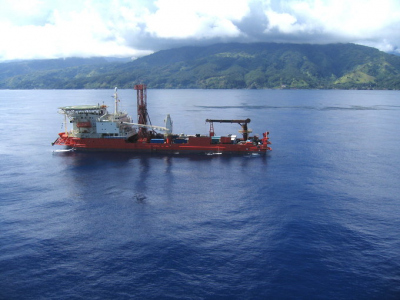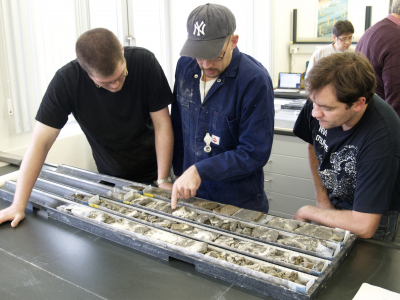Page path:
- Home
- Discover
- Media Releases
- Media Releases 2012
- 24-07-2012 Pacific Climate Snapshot - New Natur...
Pacific Climate Snapshot - New Nature Study on Corals and Climate
The final stage of the last ice age was literally initiated with considerable uproar. About 18,000 years ago the ice shields that then covered Canada, Greenland, and Scandinavia discharged massive icebergs into the Atlantic Ocean. This freshwater pulse weakened Atlantic Ocean currents for several millennia and even influenced the Asian monsoon. However, the impacts of this event on climate and weather phenomena in the tropical Pacific, and more specifically on the behaviour of the El Niño-Southern Oscillation (ENSO), have remained unclear. ENSO today is accompanied by considerable sea-surface temperature changes and followed by weather anomalies such as heavy rainfalls and droughts.
Now the South Pacific ENSO mystery of the past has been solved: “For the first time, our detailed investigations show that, in contrast to today, Tahiti was part of the ENSO sphere 15,000 years ago,” according to lead author Dr. Thomas Felis, who summarizes the most important finding: “The coral core data reveal that sea-surface temperatures in the tropical Pacific fluctuated in a typical ENSO mode of two to five years.”
“The singular aspect of this work is that the part of the core we investigated is only 60 centimetres long. However, it spans 22 years of continuous coral growth,” the geoscientist points out. 15,000 years ago the coral grew in the northern part of the reef system that borders the island of Tahiti; presumably in a water depth of less than five metres. In late 2005, when the ECORD drilling vessel DP HUNTER cored the coral, it was located 113 metres below current sea level, which has been rising steadily since the formation of the coral.
“This is a unique snapshot from our past climate”, Thomas Felis says. “The coral core archives 22 years of weather and climate. Because the core was so well preserved we were able to sample it very densely, achieving a monthly resolution for sea-surface temperature.” However, since the core covers only a short time span and in order to substantiate their findings, the coral experts cooperated with climate modellers, whose results fit well with the coral data: The computer model definitely mirrors the ENSO rhythm!
To read the paper please go to:
http://www.nature.com/ncomms/journal/v3/n7/full/ncomms1973.html
More information / interviews / images:
Now the South Pacific ENSO mystery of the past has been solved: “For the first time, our detailed investigations show that, in contrast to today, Tahiti was part of the ENSO sphere 15,000 years ago,” according to lead author Dr. Thomas Felis, who summarizes the most important finding: “The coral core data reveal that sea-surface temperatures in the tropical Pacific fluctuated in a typical ENSO mode of two to five years.”
“The singular aspect of this work is that the part of the core we investigated is only 60 centimetres long. However, it spans 22 years of continuous coral growth,” the geoscientist points out. 15,000 years ago the coral grew in the northern part of the reef system that borders the island of Tahiti; presumably in a water depth of less than five metres. In late 2005, when the ECORD drilling vessel DP HUNTER cored the coral, it was located 113 metres below current sea level, which has been rising steadily since the formation of the coral.
“This is a unique snapshot from our past climate”, Thomas Felis says. “The coral core archives 22 years of weather and climate. Because the core was so well preserved we were able to sample it very densely, achieving a monthly resolution for sea-surface temperature.” However, since the core covers only a short time span and in order to substantiate their findings, the coral experts cooperated with climate modellers, whose results fit well with the coral data: The computer model definitely mirrors the ENSO rhythm!
To read the paper please go to:
http://www.nature.com/ncomms/journal/v3/n7/full/ncomms1973.html
More information / interviews / images:
MARUM aims at understanding the role of the oceans in the Earth’s system
by employing state-of-the-art methods.
It examines the significance of the oceans
within the framework of global change,
quantifies interactions between the marine geosphere and biosphere,
and provides information for sustainable use of the ocean.
MARUM comprises the DFG research center
and the cluster of excellence "The Ocean in the Earth System".
by employing state-of-the-art methods.
It examines the significance of the oceans
within the framework of global change,
quantifies interactions between the marine geosphere and biosphere,
and provides information for sustainable use of the ocean.
MARUM comprises the DFG research center
and the cluster of excellence "The Ocean in the Earth System".




